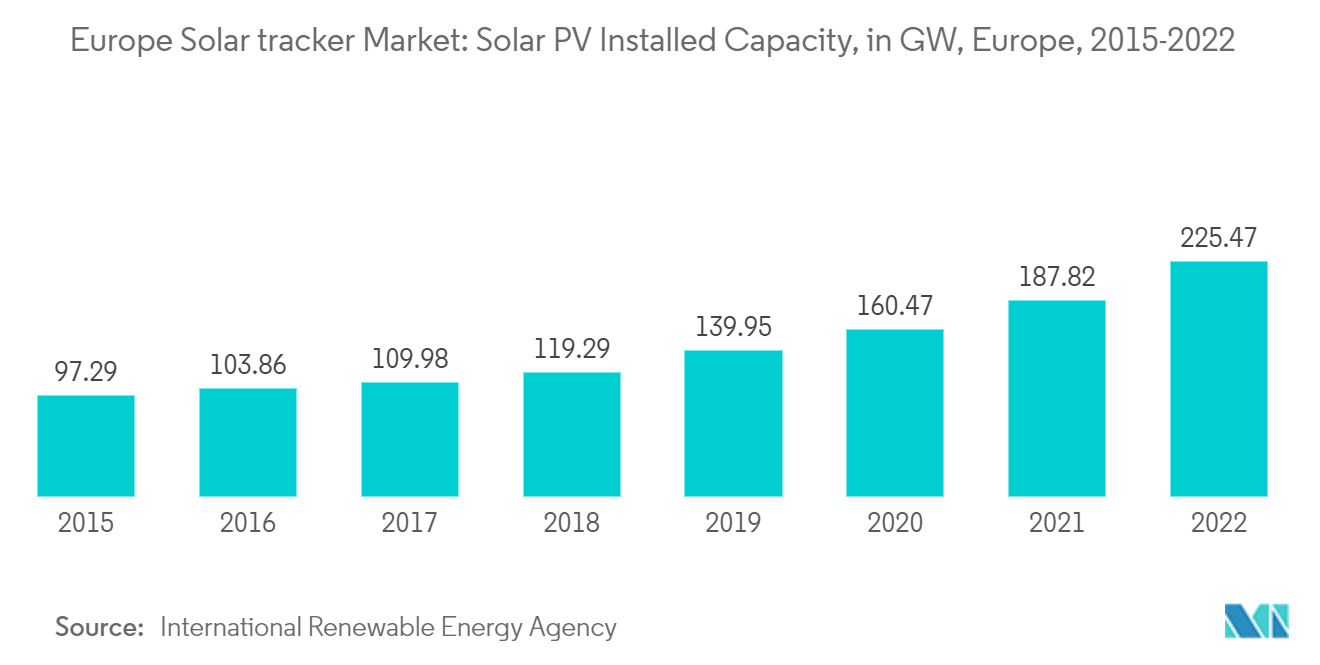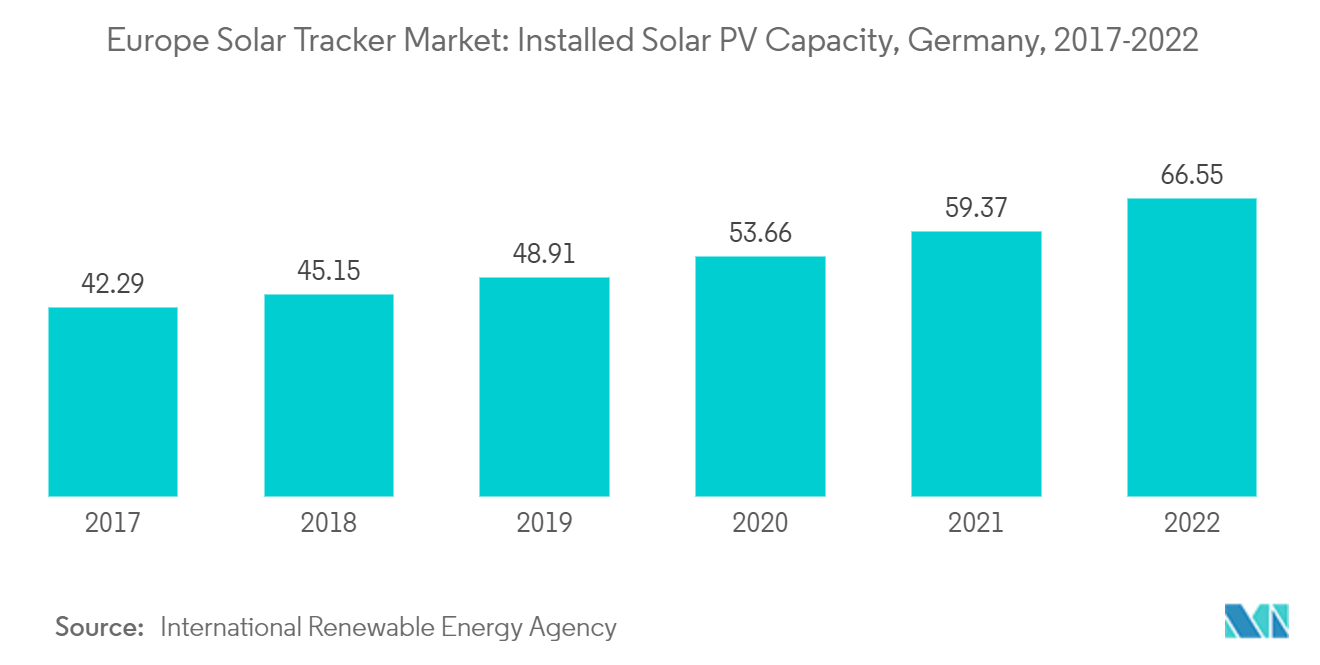Market Trends of Europe Solar Tracker Industry
Single-Axis segment to dominate the market
- A solar tracker enhances the production capacity of the solar panel system by aligning the solar panel with the direction of sunlight. The solar tracker alters the alignment of the photovoltaic (PV) panel so that the sunlight falls perpendicularly on the panel and gives maximum power output. However, they are less effective when they move farther toward the northern regions because the variance of the solar angle is higher between the summer and winter seasons in locations far from the equator.
- The single-axis solar tracker is 50% more costly than a fixed PV panel setup but provides an extra 25%-35% surge in capacity. Its simple design offers the highest density of PV panel placement per square and a shorter payback time.
- Currently, horizontal single-axis trackers (HSAT) are the leading choice among trackers since they can deliver 20-30% more energy without the added cost and complexities of dual-axis tracking systems. In addition, the decline in single-axis tracking system costs is increasing the popularity of SATs, which in turn is hindering the growth of the dual-axis tracker market.
- The single-axis tracker is 50% more costly than a fixed photovoltaic panel setup but provides an extra 25%-35% surge in energy yield. Single-axis solar trackers' simple design offers the highest density of photovoltaic panel placement per square area and a shorter payback time. At the same time, dual-axis trackers provide an extra 10% capacity enhancement but cost an extra 100% of a fixed PV panel setup.
- The installed capacity of solar photovoltaic (PV) projects has grown significantly over the last decade due to increasing investments in the renewable energy industry supported by favorable government policies and ambitious renewable energy targets set by several countries in the region. According to the International Renewable Energy Agency (IRENA), the cumulative installed solar PV capacity in Europe grew by around 20%, i.e., from 187.82 GW in 2021 to 225.47 GW in 2022.
- Furthermore, governments and energy companies face the challenge of increasing the power capacity for current and future projects. With single-axis solar trackers, the 20%-30% capacity surge can be very beneficial. It, in turn, is expected to create significant opportunities for the companies involved in single-axis solar tracking system manufacturing during the forecast period.

Germany to dominate the market
- Germany is one of the largest markets for solar PV in Europe, and due to its relatively higher latitude, it is also one of the region's largest countries for solar tracker demand. The country is also a hub for research and development of solar trackers, with several of the world's largest solar tracker producers, such as Ideematec and Deger Energie, based in Germany.
- As Germany phases out coal and nuclear from its energy mix, it faces an acute energy crisis. Due to this, Germany aggressively increased its solar PV capacity over the past few years. In November 2021, Germany committed to closing its coal-fired generation capacity by 2030. In 2030, Germany aims to fulfill its energy requirements by installing 200 GW of solar capacity.
- As Germany almost exclusively uses solar PV technology, such large-scale commitments in the solar PV sector are expected to provide a definite impetus to the demand for associated solar trackers, which is expected to significantly boost the German solar tracker market during the forecast period. According to the International Renewable Energy Agency, Germany's cumulative installed solar PV capacity grew by around 12%, i.e., from 59.37 GW in 2021 to 66.55 GW in 2022.
- Additionally, German solar tracker manufacturers are global leaders in the research and development of intelligent and more efficient solar trackers. This is expected to reduce the cost of solar trackers in the German domestic market, increasing demand during the forecast period.
- In November 2021, German solar tracker manufacturer Ideematec unveiled a one-in-portrait solar tracker. The horizontal single-axis tracker has a typical size of 1952.5 m, and its tracking range is 55 deg. The system can use up to 180 photovoltaic panels and six strings per tracker. The system can be integrated with all kinds of solar modules, including high-power products, is capable of withstanding winds of up to 180 km per hour, and is equipped with a snow sensor. The tracking system employs the astronomical algorithm 3D adaptive back-tracking, and its range and ground clearance can be increased to 60 degrees and 500 nanometers (nm) upon request.
- In October 2021, Wattmanufactur commenced operation at the 10 MW Lottorf solar park in the district of Schleswig-Flensburg/Schleswig-Holstei, one of the world's largest single-axis tracker solar parks. By 2022, the park's capacity was expected to increase by nearly 7 MW. Due to its solar tracker technology, the solar park will generate significantly more energy in the morning and evening hours. Additionally, the tracker technology allows the installation of rotating modules, which maximizes the shading possibility of the soil but at the same time continues to offer a full-surface irrigation possibility, improving the project's sustainability.
- As Germany is a mature solar market, solar subsidies are expected to be discontinued within the forecast period. Additionally, Germany has high land prices and concerns about land use patterns and ecological sustainability. Due to such factors, solar energy producers are focused on increasing efficiency and generation while reducing land use, which is expected to improve the attractiveness of novel solar tracker systems during the forecast period.

